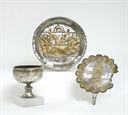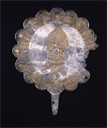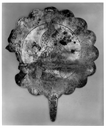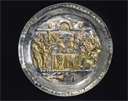Description
This fan was said to have been found together with a paten and chalice (BZ.1924.5 and BZ.1955.18, respectively) at Riha, a small village south of Aleppo in central Syria. The burial in this area was probably in response to invasions during the early seventh century first by Sasanian invaders and then by Arab forces. Because the owners had to flee or were killed, the liturgical objects were not retrieved until the early twentieth century. This group and silver treasures from nearby Stuma, Hama, and Antioch were discovered at about the same time, and it has been suggested that these hoards actually constituted one large group brought together for protective burial, which was divided into smaller sets after it was unearthed early in the twentieth century. The chalice, paten, and fan are each impressed with stamps that indicate the emperor’s reign during which it was made. The chalice was fabricated during the reign of Justinian I (527–65), while the paten and fan belong to the reign of his successor, Justin II (565–78). Although the chalice’s date indicates that it was made befpre the paten and fan, the three may well have been used together at a subsequent date. They form a set for use in the Orthodox Eucharist, or Communion: the paten held the leavened bread, still a tradition in Orthodox worship, the chalice contained the wine, and the fan was used to keep insects away from the bread and the wine. Jesus instituted the Eucharist, as recorded in the gospels of Matthew (26:26–28) and Mark (14:22–24): offerings of bread and wine to the apostles that foreshadowed the sacrifice of Christ’s body and blood.
By the fourth century feather or textile fans were used to keep insects away from the Eucharistic bread and wine. Precious metal fans, of which this is the earliest example, may have fulfilled the same function, but were also symbolic in nature. The Riha rhipidion is engraved with peacock feathers around its rim, while cherubim—the four-winged creatures described in Ezekiel 1:4–21—appear in the center of both sides. Like the prophet’s vision, the figures have “a luster like that of shining metal” and four wings, hands, and faces, known as a tetramorph. The faces are those of a man, a lion, an ox, and an eagle. The wheels are also part of the vision, for “the spirit of the creatures was in the wheels.”
The spiritual awe of Ezekiel’s vision may explain the presence of the tetramorph in the Eucharist service, but the visionary image had additional meaning in Christian terms. From a very early date, each of the four Gospel writers was associated with one form of the tetramorph: Matthew with the man; Mark with the lion; Luke with the ox; and John with the eagle. In other words, Ezekiel’s vision was understood as foreshadowing the historical character of the Four Gospels.
A fan from Stuma (in Istanbul, Archaeological Museum) is similar enough in size and design to the Riha fan that they are considered a pair. They differ insofar as the Stuma fan has seraphim with six wings engraved on it instead of the cherubim as on the Riha fan. Although no other such pairs of fans have survived, literary references and visual representations provide evidence of their existence.
S. Zwirn
Bibliography
M. Rosenberg, Der goldschmiede Merkzeichen 4, 3 ed. (Frankfurt, 1928), 684-685, fig. 9862-9869.
The Dark Ages; Loan Exhibition of Pagan and Christian Art in the Latin West and Byzantine East, exhibition catalogue, Worcester Art Museum, February 20-March 21, 1937 (Worcester, Mass., 1937), no. 114.
M. C. Ross, Bulletin of the Fogg Art Museum 9.4 (1941), esp. 72, fig. 4.
The Dumbarton Oaks Research Library and Collection of Harvard University, Handbook of the Collection (Washington, D.C., 1946), 53, no. 103, fig. p. 57.
The Dumbarton Oaks Collection, Harvard University (Washington, D.C., 1955), 54, no. 128, fig. p. 67.
R. J. Gettens and C. A. Waring, "The Composition of Some Ancient Persian and Other Near Eastern Silver Objects," Ars Orientalis 2 (1957): 83-90, esp. 89, no. 17.
E. C. Dodd, Byzantine Silver Stamps, Dumbarton Oaks Studies 7 (Washington, D.C., 1961), no. 21.
M. C. Ross, Catalogue of the Byzantine and Early Mediaeval Antiquities in the Dumbarton Oaks Collection, Vol. 1, Metalwork, Ceramics, Glass, Glyptics, Painting, (Washington, D.C., 1962), 15, no. 11, pl. 14, 15.
Handbook of the Byzantine Collection (Washington, D.C., 1967), 17-18, no. 62.
E. C. Dodd, "Byzantine Silver Stamps: Supplement II: More Treasures from Syria," Dumbarton Oaks Papers 22 (1968): 141-49, esp. 147.
K. Wessel, "Flabellum," Reallexikon zur byzantinischen Kunst (Stuttgart, 1971) cols. 550-51.
E. C. Dodd, Byzantine Silver Treasures, Monographien der Abegg-Stiftung, Bern, 9 (Bern, 1974), 35-48, fig. 28, 30, 32, 33.
J. P. C. Kent and K. S. Painter, Wealth of the Roman World : AD 300-700, exhibition catalogue, British Museum, (London, 1977), 83-84, no. 145.
K. Weitzmann, Age of Spirituality : Late Antique and Early Christian Art, Third to Seventh Century, ed. K. Weitzmann, exhibition catalogue, Metropolitan Museum of Art, November 19, 1977-February 12, 1978 (New York, 1979), 617-618, no. 553.
M. M. Mango, C. E. Snow, and T. Drayman Weisser, Silver from Early Byzantium: the Kaper Koraon and Related Treasures, exhibition catalogue, Walters Art Gallery, 18-August 17, 1986 (Baltimore, Md., 1986), no. 32.
S. Boyd, "Art in the Service of the Liturgy: Byzantine Silver Plate," in Heaven on Earth: Art and the Church in Byzantium ed. L. Safran (University Park, Pa., 1998), 160-63, fig. 6.8, 6.9.
B. Lang, "Why Has God so Many Names?," Bible Review (August 2003).
R. S. Nelson, K. M. Collins, and C. Barber, Holy Image, Hallowed Ground : Icons from Sinai, exhibition catalogue, J. Paul Getty Museum, November 14, 2006-March 4, 2007 (Los Angeles, 2006), 218-219, no. 38.
G. Bühl, ed., Dumbarton Oaks: The Collections (Washington, D.C., 2008), 76, 82, pl. p. 77, 83.
A. Doig, Liturgy and Architecture from the Early Church to the Middle Ages, Liturgy, Worship, and Society (Aldershot, England and Burlington, Vt., 2008), 72, 73, fig. 3.8.
H. Hunter-Crawley, "Embodying the Divine: The Sensational Experience of the Sixth-Century Eucharist," in Making Senses of the Past: Toward a Sensory Archaeology, Center for Archaeological Investigations Occasional Paper, ed. J. Day (Carbondale, IL, 2013), esp. 168, fig. 8-3.
P. Cesaretti and B. Hamarneh. Testo agiografico e orizzonte visivo: ricontestualizzare le Vite dei saloi Simeone e Andrea, BHG 1677-115z. Testi e studi bizantino-neoellenici 20 (2016), fig. 25
Bergmeier, Armin F. Visionserwartung : Visualisierung Und Präsenzerfahrung Des Göttlichen in Der Spätantike. Spätantike, Frühes Christentum, Byzanz. Reihe B, Studien Und Perspektiven ; Bd. 43. Wiesbaden: Reichert Verlag, 2017: 160, fig. 82.
Exhibition History
Worcester, MA, Worcester Art Museum, "Art of the Dark Ages," Feb. 19 - Mar. 29, 1937.
Cambridge, MA, Fogg Art Museum, "A Selection of Ivories, Bronzes, Metalwork and Other Objects from the Dumbarton Oaks Collection," Nov. 15 - Dec. 31, 1945.
London, The British Museum, "Wealth of the Roman World," Mar. 25 - Oct. 3, 1977.
New York, Metropolitan Museum of Art, "Age of Spirituality: Late Antique and Early Christian Art, Third to Seventh Century," Nov. 19, 1977 - Feb. 12, 1978.
Baltimore, Walters Art Gallery, "Silver Treasure from Early Byzantium," Apr. 18 - Aug. 17, 1986.
Los Angeles, J. Paul Getty Museum, "Holy Image, Hallowed Ground: Icons from Sinai," Nov. 14, 2006 - March 4, 2007.








